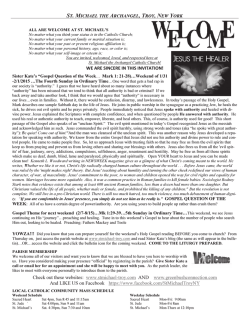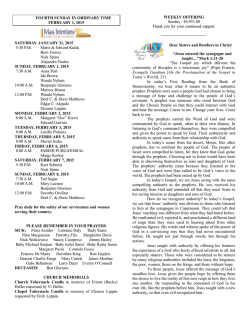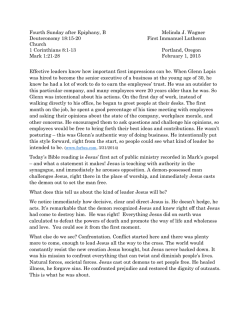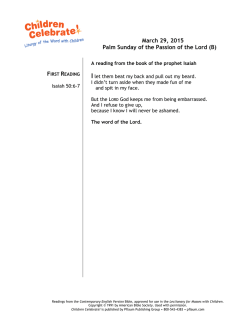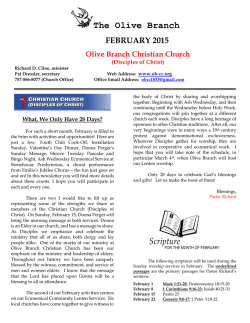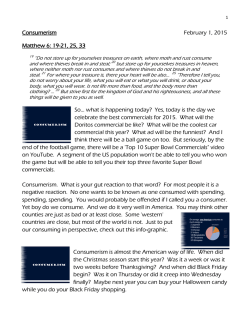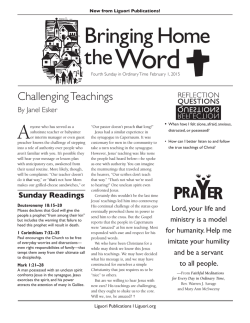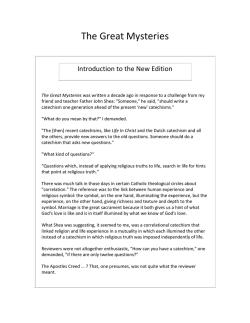
FEBRUARY 1, 2015: FOURTH SUNDAY OF THE YEAR
FEBRUARY 1, 2015: FOURTH SUNDAY OF THE YEAR Deuteronomy 18:15-20 I Corinthians 7:32-35 Mark 1:21-28 When asked, “What was Jesus’ first miracle?” most Christians will respond, “Changing water into wine at Cana in Galilee.” That’s correct – if you’re dealing with John’s gospel. But no other evangelist even mentions that miracle. Gospel miracles are always important, not because the gospel authors expect their readers to “ooh and aah” over Jesus’ supernatural powers, but because miracles give us an insight into what the historical Jesus of Nazareth was about, and on what levels we’re to imitate and surface the risen Jesus in our daily lives. Each evangelist carefully picks the miracles he narrates. This is especially true of each gospel’s first miracle. That specific wondrous action usually sets the theme for the entire gospel. It tells the reader what Jesus of Nazareth is all about. That’s why today’s Marcan pericope is so significant: it narrates his Jesus’ first miracle. During Jesus’ day, demons were looked upon as being responsible for most of the evil in the world; not just moral, sinful evil, but any evil. If, for instance, I woke up this morning with a bad cold, I could logically presume several cold demons had finagled their way into my body during the night. So if, before Mark’s Jesus does anything else, he exorcises a demoniac, the evangelist is letting us know that the focal point of Jesus’ ministry is the eradication of evil – both moral and physical. The demon’s question is rhetorical: “What have you to do with us, Jesus of Nazareth? Have you come to destroy us?” For followers of Jesus, the answer is a resounding, “Yes!” We’re called to spend a lifetime eradicating as much evil in our world as we possibly can. Paul, as we hear in our second reading, believes we should remove anything from our lives which could keep us from achieving that goal – even marriage. When he dictates I Corinthians, he still believes Jesus’ Parousia is just around the corner. He reasons it would be foolish to get involved in all that marriage demands if Jesus is coming back in less than a few years. I presume he’d approach the issue differently were he speaking to people living more than 2,000 years after Jesus’ death and resurrection. But even in his day and age he realizes how controversial his advice is. That’s why he ends the passage with the disclaimer, “I am telling you this for your own benefit, not to impose a restraint upon you.” A long term faith forces us to look at marriage from a different perspective than the early church’s short term faith. But, back to the gospel. How do we know on what evil to concentrate? What are God’s priorities? Our Deuteronomy author tells us what process to employ: prophets. The normal biblical way of surfacing God’s will is to surface the prophets in our midst and listen to them. That’s why the writer makes a big thing of Moses’ death. He’s not only the people’s liberator, he’s also their prophet. He’s their conscience: the person who constantly informs them of the future implications of their present actions. After his death, how will they find out what God wants them to do? Moses assures his people he’s not the last prophet. “A prophet like me will Yahweh, your God, raise up for you, from among your own kin; to whom shall you listen.” Though some interpret this to mean just one prophet, like Moses, will eventually arise, most believe it simply means every generation will have the prophets it needs. If we’re to eradicate evil, and we have prophets who are showing us what evil to get rid of, then we’d best learn the rules for distinguishing real prophets from fake prophets. Otherwise we’re going to have problems. COPYRIGHT 2015 – ROGER VERMALEN KARBAN FEBRUARY 8, 2015: FIFTH SUNDAY OF THE YEAR Job 7:1-4, 5-7 I Corinthians 9:17-19, 22-23 Mark 1:29-39 Though we can presume the historical Jesus prayed often during any given day of his earthly existence, Mark’s Jesus only prays when he’s under “messianic stress:” when he’s trying to figure out what God wants him, as a prophet, to say and do. I mentioned in last week’s commentary that, given our sacred authors’ emphasis on prophecy, it’s essential to know how to distinguish real prophets from fake prophets. The first rule: real prophets always take us back to the beginnings of our faith; fake prophets never go back that far. The latter concentrate on things which entered the faith years or centuries after the founder’s original insights; things which are usually far less demanding than those original essentials. The gospel Jesus, for instance, rejected any violence, even in retaliation. But less than four centuries later, St. Augustine developed the concept of a “just war.” What’s forbidden in the beginning, eventually becomes acceptable. Like ourselves, Jesus of Nazareth would have agonized over those essentials. How far back does he go? How much of himself is he willing to commit to this endeavor? He was also well aware of the second and third rules for picking real from fake prophets: the former not only can’t make a living from prophecy, they always suffer for delivering the message Yahweh demands they give. Could he endure the suffering such a ministry entailed? Today’s Marcan pericope concludes the first gospel day of Jesus’ public ministry. He’s exorcised “many demons,” and besides healing Simon’s fevered mother-in-law, he also “cured many who were sick with various diseases.” Quite a successful day. No wonder “Simon and those who were with him pursued him” the next morning. They probably had several TV interviews scheduled, and were accompanied by a couple of reporters anxious to do a story on this local carpenter. He must have blown their minds when, instead of returning triumphantly to town, he announces, “Let us go on to the nearby villages that I may preach there also. For this purpose have I come.” If this narrative is historically accurate, I presume on Good Friday evening, some of his first disciples would have argued, “We should have stayed in Capernaum. He went to one village and one synagogue too far.” This passage paints a picture of someone willing to go beyond what “normal” people would expect God to demand. Why didn’t he remain in a place that accepted him, preaching God’s prophetic word to friendly audiences? He could have become a local, revered personality; instead he ends up dying on a Jerusalem cross. Marcan scholars point out the Greek vocabulary employed in this “deserted place” pericope is identical to the vocabulary used in the evangelist’s agony in the garden passage. That implies Jesus most probably experienced more than one agony. (And it also helps us understand how the three Gethsemane eyewitnesses, though fast asleep, still knew what Jesus was going through. He had experienced similar agonies on other occasions – while they were awake.) God constantly demands we go beyond our comfort zone, and endure the agonies which follow and precede such actions. Paul mentions he also went beyond that zone in evangelizing the Corinthian church. Not only did he refuse to do something even Jesus permitted – be materially supported by the community he’s evangelizing – but he also takes the unexpected step of becoming one with each of his converts. “I have made myself a slave to all . . . . To the weak I became weak, to win over the weak. I have become all things to all . . . .” I presume neither Jesus nor Paul ever identified with Job’s “life is a drudgery” experience. But they also were willing to pay the price for making life interesting. COPYRIGHT 2015 – ROGER VERMALEN KARBAN
© Copyright 2025
